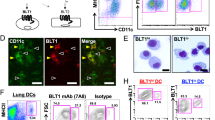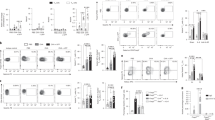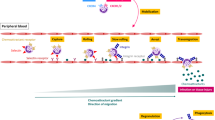Abstract
Leukotriene B4 (LTB4) was originally described as a potent lipid myeloid cell chemoattractant, rapidly generated from innate immune cells, that activates leukocytes through the G protein–coupled receptor BLT1. We report here that BLT1 is expressed on effector CD4+ T cells generated in vitro as well as in vivo when effector T cells migrate out of the lymphoid compartment and are recruited into peripheral tissues. BLT1 mediated LTB4-induced T helper type 1 (TH1) and TH2 cell chemotaxis and firm adhesion to endothelial cells under flow, as well as early CD4+ and CD8+ T cell recruitment into the airway in an asthma model. Our findings show that the LTB4-BLT1 pathway is involved in linking early immune system activation and early effector T cell recruitment.
This is a preview of subscription content, access via your institution
Access options
Subscribe to this journal
Receive 12 print issues and online access
$209.00 per year
only $17.42 per issue
Buy this article
- Purchase on Springer Link
- Instant access to full article PDF
Prices may be subject to local taxes which are calculated during checkout







Similar content being viewed by others
References
Butcher, E.C. & Picker, L.J. Lymphocyte homing and homeostasis. Science 272, 60–66 (1996).
Banchereau, J. & Steinman, R.M. Dendritic cells and the control of immunity. Nature 392, 245–252 (1998).
Abbas, A.K., Murphy, K.M. & Sher, A. Functional diversity of helper T lymphocytes. Nature 383, 787–793 (1996).
von Andrian, U.H. & Mackay, C.R. T-cell function and migration. Two sides of the same coin. N. Engl. J. Med. 343, 1020–1034 (2000).
Campbell, J.J. & Butcher, E.C. Chemokines in tissue-specific and microenvironment-specific lymphocyte homing. Curr. Opin. Immunol. 12, 336–341 (2000).
Weninger, W., Manjunath, N. & von Andrian, U.H. Migration and differentiation of CD8+ T cells. Immunol. Rev. 186, 221–233 (2002).
Mathew, A. et al. Signal transducer and activator of transcription 6 controls chemokine production and T helper cell type 2 cell trafficking in allergic pulmonary inflammation. J. Exp. Med. 193, 1087–1096 (2001).
Mathew, A., Medoff, B.D., Carafone, A.D. & Luster, A.D. Cutting edge: Th2 cell trafficking into the allergic lung is dependent on chemoattractant receptor signaling. J. Immunol. 169, 651–655 (2002).
Murphy, P.M. The molecular biology of leukocyte chemoattractant receptors. Annu. Rev. Immunol. 12, 593–633 (1994).
Haeggstrom, J.Z. & Wetterholm, A. Enzymes and receptors in the leukotriene cascade. Cell. Mol. Life. Sci. 59, 742–753 (2002).
Paterson, N.A., Wasserman, S.I., Said, J.W. & Austen, K.F. Release of chemical mediators from partially purified human lung mast cells. J. Immunol. 117, 1356–1362 (1976).
Heavey, D.J. et al. Generation of leukotriene C4, leukotriene B4, and prostaglandin D2 by immunologically activated rat intestinal mucosa mast cells. J. Immunol. 140, 1953–1957 (1988).
Huang, W.W. et al. Molecular and biological characterization of the murine leukotriene B4 receptor expressed on eosinophils. J. Exp. Med. 188, 1063–1074 (1998).
Yokomizo, T., Kato, K., Terawaki, K., Izumi, T. & Shimizu, T. A second leukotriene B4 receptor, BLT2: A new therapeutic target in inflammation and immunological disorders. J. Exp. Med. 192, 421–432 (2000).
Tager, A.M. et al. BLTR mediates leukotriene B4-induced chemotaxis and adhesion and plays a dominant role in eosinophil accumulation in a murine model of peritonitis. J. Exp. Med. 192, 439–446 (2000).
Bleul, C.C., Fuhlbrigge, R.C., Casasnovas, J.M., Aiuti, A. & Springer, T.A. A highly efficacious lymphocyte chemoattractant, stromal cell-derived factor 1 (SDF-1). J. Exp. Med. 184, 1101–1109 (1996).
Gerszten, R.E. et al. MCP-1 and IL-8 trigger firm adhesion of monocytes to vascular endothelium under flow conditions. Nature 398, 718–723 (1999).
Barnden, M.J., Allison, J., Heath, W.R. & Carbone, F.R. Defective TCR expression in transgenic mice constructed using cDNA-based α- and β-chain genes under the control of heterologous regulatory elements. Immunol. Cell. Biol. 76, 34–40 (1998).
Reinhardt, R.L., Khoruts, A., Merica, R., Zell, T. & Jenkins, M.K. Visualizing the generation of memory CD4 T cells in the whole body. Nature 410, 101–105 (2001).
Shindo, K., Fukumura, M. & Miyakawa, K. Leukotriene B4 levels in the arterial blood of asthmatic patients and the effects of prednisolone. Eur. Respir. J. 8, 605–610 (1995).
Sampson, A.P., Castling, D.P., Green, C.P. & Price, J.F. Persistent increase in plasma and urinary leukotrienes after acute asthma. Arch. Dis. Child. 73, 221–225 (1995).
Wenzel, S.E. et al. Effect of 5-lipoxygenase inhibition on bronchoconstriction and airway inflammation in nocturnal asthma. Am. J. Respir. Crit. Care Med. 152, 897–905 (1995).
Csoma, Z. et al. Increased leukotrienes in exhaled breath condensate in childhood asthma. Am. J. Respir. Crit. Care Med. 166, 1345–9 (2002).
Turner, C.R. et al. In vitro and in vivo effects of leukotriene B4 antagonism in a primate model of asthma. J. Clin. Invest. 97, 381–387 (1996).
Henderson, W.R., Jr. et al. The importance of leukotrienes in airway inflammation in a mouse model of asthma. J. Exp. Med. 184, 1483–1494 (1996).
Goodarzi, K., Goodarzi, M., Tager, A.M., Luster, A.D. & von Andrian, U.H. Leukotriene B4 and BLT1 control cytotoxic effector T cell recruitment to inflamed tissues. Nat. Immunol. Published online 31 August 2003; doi:10.1038/ni972.
MacLean, J.A., Sauty, A., Luster, A.D., Drazen, J.M. & De Sanctis, G.T. Antigen-induced airway hyperresponsiveness, pulmonary eosinophilia, and chemokine expression in B cell-deficient mice. Am. J. Resp. Cell Mol. Biol. 20, 379–387 (1999).
Oshiba, A. et al. Passive transfer of immediate hypersensitivity and airway hyperresponsiveness by allergen-specific immunoglobulin (Ig) E and IgG1 in mice. J. Clin. Invest. 97, 1398–1408 (1996).
al-Laith, M. et al. Immunoglobulin-G-dependent stimulation of guinea pig lung mast cells and macrophages. Allergy 48, 608–614 (1993).
Cohn, L., Homer, R.J., Marinov, A., Rankin, J. & Bottomly, K. Induction of airway mucus production by T helper 2 (Th2) cells: a critical role for interleukin 4 in cell recruitment but not mucus production. J. Exp. Med. 186, 1737–1747 (1997).
Katz, H.R. et al. Secretory granule mediator release and generation of oxidative metabolites of arachidonic acid via Fc-IgG receptor bridging in mouse mast cells. J. Immunol. 148, 868–671 (1992).
Hsueh, W., Gonzalez-Crussi, F. & Henderson, S. LTB4 production and lysosomal enzyme release by rat alveolar macrophages: effects of phagocytosis, receptor binding, and ionophore stimulation. Exp. Lung Res. 13, 385–399 (1987).
Rankin, J.A., Schrader, C.E., Smith, S.M., Lewis, R.A. & Lewis, C.R. Recombinant interferon-γ primes alveolar macrophages cultured in vitro for the release of leukotriene B4 in response to IgG stimulation. J. Clin. Invest. 83, 1691–1700 (1989).
Borgeat, P. & Samuelsson, B. Transformation of arachidonic acid by rabbit polymorphonuclear leukocytes. Formation of a novel dihydroxyeicosatetraenoic acid. J. Biol. Chem. 254, 2643–2646 (1979).
Ford-Hutchinson, A.W., Bray, M.A., Doig, M.V., Shipley, M.E. & Smith, M.J. Leukotriene B, a potent chemokinetic and aggregating substance released from polymorphonuclear leukocytes. Nature 286, 264–265 (1980).
Smith, M.J., Ford-Hutchinson, A.W. & Bray, M.A. Leukotriene B: a potential mediator of inflammation. J. Pharm. Pharmacol. 32, 517–518 (1980).
Yokomizo, T., Izumi, T., Chang, K., Takuwa, Y. & Shimizu, T. A G-protein-coupled receptor for leukotriene B4 that mediates chemotaxis. Nature 387, 620–624 (1997).
Arcoleo, F., Milano, S., D'Agostino, P. & Cillari, E. Effect of exogenous leukotriene B4 (LTB4) on BALB/c mice splenocyte production of Th1 and Th2 lymphokines. Int. J. Immunopharmacol. 17, 457–463 (1995).
Yamaoka, K.A. & Kolb, J.P. Leukotriene B4 induces interleukin 5 generation from human T lymphocytes. Eur. J. Immunol. 23, 2392–2398 (1993).
de Jong, E.M., van Erp, P.E., van Vlijmen, I.M. & van de Kerkhof, P.C. The inter-relation between inflammation and epidermal proliferation in normal skin following epicutaneous application of leukotriene-B4—an immunohistochemical study. Clin. Exp. Dermatol. 17, 413–420 (1992).
Hamid, Q., Tulic, M.K., Liu, M.C. & Moqbel, R. Inflammatory cells in asthma: mechanisms and implications for therapy. J. Allergy & Clin. Immunol. 111, S5–S17 (2003).
Krump, E. & Borgeat, P. Kinetics of 5-lipoxygenase activation, arachidonic acid release, and leukotriene synthesis in human neutrophils: effects of granulocyte-macrophage colony-stimulating factor. Biochim. Biophys. Acta. 1213, 135–139 (1994).
Reinhardt, R.L., Bullard, D.C., Weaver, C.T. & Jenkins, M.K. Preferential accumulation of antigen-specific effector CD4 T cells at an antigen injection site involves CD62E-dependent migration but not local proliferation. J. Exp. Med. 197, 751–762 (2003).
Sallusto, F., Lenig, D., Mackay, C.R. & Lanzavecchia, A. Flexible programs of chemokine receptor expression on human polarized T helper 1 and 2 lymphocytes. J. Exp. Med. 187, 875–883 (1998).
Kim, C.H. et al. Rules of chemokine receptor association with T cell polarization in vivo. J. Clin. Invest. 108, 1331–1339 (2001).
Colantonio, L., Recalde, H., Sinigaglia, F. & D'Ambrosio, D. Modulation of chemokine receptor expression and chemotactic responsiveness during differentiation of human naive T cells into Th1 or Th2 cells. Eur. J. Immunol. 32, 1264–1273 (2002).
Weninger, W., Crowley, M.A., Manjunath, N. & von Andrian, U.H. Migratory properties of naive, effector, and memory CD8+ T cells. J. Exp. Med. 194, 953–966 (2001).
Means, T.K., Hayashi, F., Smith, K.D., Aderem, A. & Luster, A.D. The Toll-like receptor 5 stimulus bacterial flagellin induces maturation and chemokine production in human dendritic cells. J. Immunol. 170, 5165–5175 (2003).
Allport, J.R. et al. Neutrophils from MMP-9- or neutrophil elastase-deficient mice show no defect in transendothelial migration under flow in vitro. J. Leukoc. Biol. 71, 821–828 (2002).
Medoff, B.D. et al. IFN-γ-inducible protein 10 (CXCL10) contributes to airway hyperreactivity and airway inflammation in a mouse model of asthma. J. Immunol. 168, 5278–5286 (2002).
Openshaw, P. et al. Heterogeneity of intracellular cytokine synthesis at the single-cell level in polarized T helper 1 and T helper 2 populations. J. Exp. Med. 182, 1357–1367 (1995).
Bird, J.J. et al. Helper T cell differentiation is controlled by the cell cycle. Immunity 9, 229–237 (1998).
MacLean, J.A., Ownbey, R. & Luster, A.D. T cell-dependent regulation of eotaxin in antigen-induced pulmonary eosinophila. J. Exp. Med. 184, 1461–1469 (1996).
Acknowledgements
The authors thank C.P. Leary for technical assistance. This work is funded by National Institutes of Health grants K08-HL04087 (A.M.T.), F32-AI54107 (S.K.B.), F32-AI50399 (B.D.M.), R01-HL65584 (R.E.G.), and R01-AI050892, R01-AI46999, R01-AI40618, R01-CA69212 and PPG-DK5005 (A.D.L.), and by a Warren-Whitman-Richardson Fellowship (Harvard Medical School; S.A.I.).
Author information
Authors and Affiliations
Corresponding author
Ethics declarations
Competing interests
The authors declare no competing financial interests.
Rights and permissions
About this article
Cite this article
Tager, A., Bromley, S., Medoff, B. et al. Leukotriene B4 receptor BLT1 mediates early effector T cell recruitment. Nat Immunol 4, 982–990 (2003). https://doi.org/10.1038/ni970
Received:
Accepted:
Published:
Issue Date:
DOI: https://doi.org/10.1038/ni970
This article is cited by
-
Activation of leukotriene B4 receptor 1 is a prerequisite for complement receptor 3-mediated antifungal responses of neutrophils
Cellular & Molecular Immunology (2024)
-
Metabolomic changes in polyunsaturated fatty acids and eicosanoids as diagnostic biomarkers in Mycobacterium avium ssp. paratuberculosis (MAP)-inoculated Holstein–Friesian heifers
Veterinary Research (2022)
-
Blockade of the BLT1-LTB4 axis does not affect mast cell migration towards advanced atherosclerotic lesions in LDLr−/− mice
Scientific Reports (2022)
-
A review of non-prostanoid, eicosanoid receptors: expression, characterization, regulation, and mechanism of action
Journal of Cell Communication and Signaling (2022)
-
Leukocyte trafficking to the lungs and beyond: lessons from influenza for COVID-19
Nature Reviews Immunology (2021)



